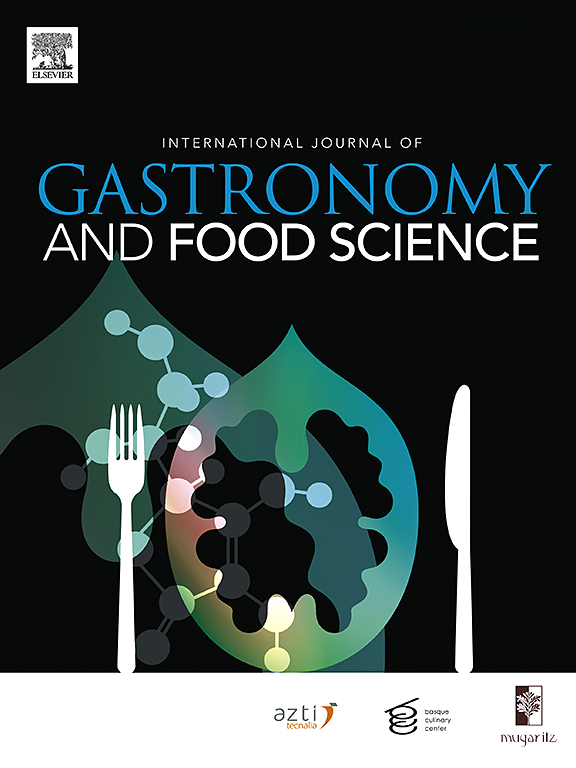不同茶泡对鲜盐白面煮制、口感和微观结构的影响
IF 3.2
2区 农林科学
Q2 FOOD SCIENCE & TECHNOLOGY
International Journal of Gastronomy and Food Science
Pub Date : 2024-12-16
DOI:10.1016/j.ijgfs.2024.101089
引用次数: 0
摘要
本研究研究了茶叶、微生物转谷氨酰胺酶(MTG)和大豆分离蛋白(SPI)组合对白盐面(WSN)的蒸煮特性、面团和面条的pH值、颜色、质地、拉伸强度和微观结构的新影响。加入1.5g氯化钠(NaCl),加入含有2.5%绿茶(GT)、乌龙茶(OT)、红茶(BT)或白茶(WT)、1.5% MTG和5% SPI的mtgspi -茶。泡茶面条的最佳蒸煮时间(6 ~ 6.5 min)短于WSN-NaCl(对照)和WSN-MTGSPI (8 min)。对照和WSN-MTGSPI- wt蒸煮产量最高,WSN-MTGSPI蒸煮损失最低。茶叶添加剂影响面团pH值,其中WSN-MTGSPI-GT蒸煮后pH值最高。所有WSN都转向黄色调。WSN-MTGSPI、WSN-MTGSPI- gt、WSN-MTGSPI- bt和WSN-MTGSPI- ot较对照结实。WSN-MTGSPI-BT出现了显着的茶泡面,与对照组相比,其烹饪时间缩短,质地更紧实,微观结构更致密。这些结果表明,茶叶,特别是BT,与MTG和SPI的掺入提高了WSN的质量,提供了一种新的增强,表明开发优质,健康导向的面条产品的潜力。本文章由计算机程序翻译,如有差异,请以英文原文为准。

Impact of various tea infusions on the cooking, texture, and microstructure of fresh white salted noodles
The current study investigated the novel impacts of teas, microbial transglutaminase (MTG), and soy protein isolate (SPI) combinations on the cooking characteristics, pH of dough and noodles, color, texture, tensile strength, and microstructure of white-salted noodles (WSN). Sodium chloride (NaCl) was added at 1.5g, with MTGSPI-teas containing 2.5% green tea (GT), oolong tea (OT), black tea (BT), or white tea (WT), along with 1.5% MTG and 5% SPI of flour weight. The optimal cooking time of tea-infused noodles was shorter (6–6.5 min) than that of WSN-NaCl (control) and WSN-MTGSPI (8 min). Control and WSN-MTGSPI-WT yielded the highest cooking yields, while WSN-MTGSPI showed the lowest cooking loss. Tea additives influenced dough pH, with WSN-MTGSPI-GT exhibiting the highest pH after cooking. All WSN shifted towards yellower tones. WSN-MTGSPI, WSN-MTGSPI-GT, WSN-MTGSPI-BT, and WSN-MTGSPI-OT were firmer than control. WSN-MTGSPI-BT emerged as notable tea-infused noodles, displaying reduced cooking durations, firmer textures, and denser microstructure compared to control. These findings showed that the incorporation of tea, especially BT, with MTG and SPI improved the quality of WSN, offering a novel enhancement, suggesting potential for developing premium, health-oriented noodle products.
求助全文
通过发布文献求助,成功后即可免费获取论文全文。
去求助
来源期刊

International Journal of Gastronomy and Food Science
Social Sciences-Cultural Studies
CiteScore
5.30
自引率
10.50%
发文量
170
审稿时长
45 days
期刊介绍:
International Journal of Gastronomy and Food Science is a peer-reviewed journal that explicitly focuses on the interface of food science and gastronomy. Articles focusing only on food science will not be considered. This journal equally encourages both scientists and chefs to publish original scientific papers, review articles and original culinary works. We seek articles with clear evidence of this interaction. From a scientific perspective, this publication aims to become the home for research from the whole community of food science and gastronomy.
IJGFS explores all aspects related to the growing field of the interaction of gastronomy and food science, in areas such as food chemistry, food technology and culinary techniques, food microbiology, genetics, sensory science, neuroscience, psychology, culinary concepts, culinary trends, and gastronomic experience (all the elements that contribute to the appreciation and enjoyment of the meal. Also relevant is research on science-based educational programs in gastronomy, anthropology, gastronomic history and food sociology. All these areas of knowledge are crucial to gastronomy, as they contribute to a better understanding of this broad term and its practical implications for science and society.
 求助内容:
求助内容: 应助结果提醒方式:
应助结果提醒方式:


